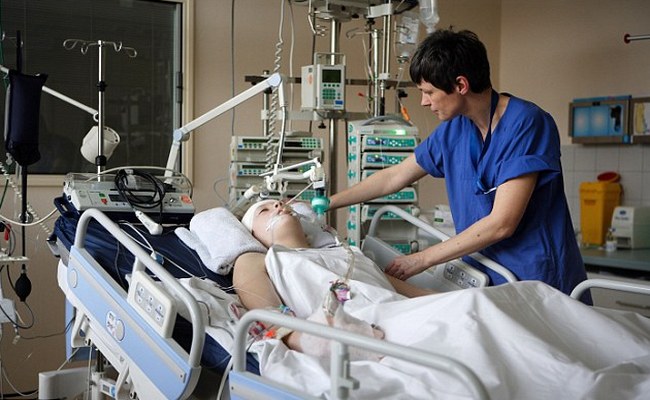Definition of Coma or Comatose Patient:
In medicine, coma is a state of unconsciousness in which a person: cannot be awakened, fails to respond normally too painful stimuli, light, or sound; lacks a normal wake-sleep cycle; and does not initiate voluntary actions.

How Will You Assess The Comatose Patient?
A. Immediate assessment of the patient:
a). Level of consciousness by Glasgow coma scale,
b). Airway,
c). Pulse,
d). Pupil (fixed, dilated),
e). Respiration,
f). Temperature,
g). Presence of trauma.
B. Further assessment:
a) History from attendance of-
- Duration of un-consciousness,
- Fever,
- Vomiting / Diarrhoea,
- Blood transfusion,
- Travelling history,
- Drug history of DM taken immediate after meal,
- Trauma,
- HTN,
- DM,
- Epilepsy,
- Poisoning,
- Jaundice.
b) Examination:
1. General examination:
- Pulse,
- BP,
- Temperature,
- Skin color texture & presence of injection bites,
- Smell of breath, vomiting,
- Hiccup, respiration rate, depth & type.
2. Neurological examination:
- Signs of head injury – local bruising, fractures, wounds, bleeding.
- Pupillary size, shape, and reaction to light.
- Fundi, ocular movement, reflexes.
- Limbs movement.
- Signs of meningeal irritation- neck rigidity, kernig’s sign.
3. CVS examinations:
- To see presence of HTN,
- Rheumatic heart diseases,
- Infective endocarditis.
4. Respiratory system:
- To see presence of HTN,
- Rheumatic heart diseases,
- Infective endocarditis.
5. Urinary system:
- To see presence of urinary retention.
Medical Management of Unconscious or Comatose Patient:
Sign and Symptoms of Coma:
- Loss of consciousness is qualitative,
- Projectile vomiting,
- Asymmetric pupils,
- GCS less than 13,
- Severe headache,
- Papilledema,
- Pupillary reaction to light slow down or negative,
- Fever,
- Restless,
- Seizures,
- Retention of mucus / sputum in the throat,
- Retention or urinary incontinence,
- Hypertension or hypotension ,
- Tachycardia or bradycardia,
- Tachypnoea or dyspnea,
- Local edema or anasarka,
- Cyanosis, pallor.
Investigation:
a) Routine investigations:
- Blood for TC, DC, ESR, Hb%, platelets, BT, CT
- Blood sugar level
- electrolytes
- Urine RME
- Chest X-ray
- ECG
b) To detect the risk factor:
- Blood sugar (2 hours after 75 gm of glucose)
- lipid profile.
c) To find out the level of lesion:
- CT scan (for haemor rhagic stroke),
- MRI (for infarctive -stroke),
- Cerebral angiography,
- Doppler USG of carotid artery.
Immediate Management:
- Maintenance of airway: clear airway (oropharyngeal suction) if necessary.
- Maintenance of breathing:
- Only neck extended & lateral position if respiration is ok.
- Mouth to mouth breathing, 02 inhalation, intubation, tracheostomy if necessary.
- Maintenance of circulation: Cardiac pulmonary resuscitation, secure IV channel & start normal saline if appropriate.
- If dehydration by vomiting -Cholera saline.
- If overhydrated -diuretics
- Maintain intake output chart.
- BP, if SBP > 240 mm of Hg & DBP >120 mm of Hg then reduce BP, otherwise not necessary, if BP does not comes to normal even after 1stweek then start antihypertensive agents.
- Blood glucose maintaining: > 11.l mmol/l it reduces by insulin (Increased blood glucose- Increased infarction).
General Treatment:
- First pay attention to airway, breathing, circulation.
- Maintenance of nutrition – Give the patient ryles tube feeding 2hourly. Liquid diet is given the help of 50cc syringe adequate carbohydrate and high protein should be present in diet.
- Care of skin – Change the posture of the patient 2 hourly. Keep the skin dry and clean.
- Care of mouth – Antifungal agent is used to prevent candida infection.
- Care of eye – Chloramphenicol eye drop to prevent exposure keratitis.
- Care of bowel- Bed pan is used to prevent soiling of cloth.
- Care of bladder – Catheterization is done.
- Control of infection by antibiotic.

Maria Khatun Mona is a Founder and Editor of Nursing Exercise Blog. She is a Nursing and Midwifery Expert. Currently she is working as a “Senior Staff Nurse” at “Dinajpur Medical College Hospital”, Bangladesh. She has great passion in writing different articles on Nursing and Midwifery. Mail her at “maria.mona023@gmail.com”
